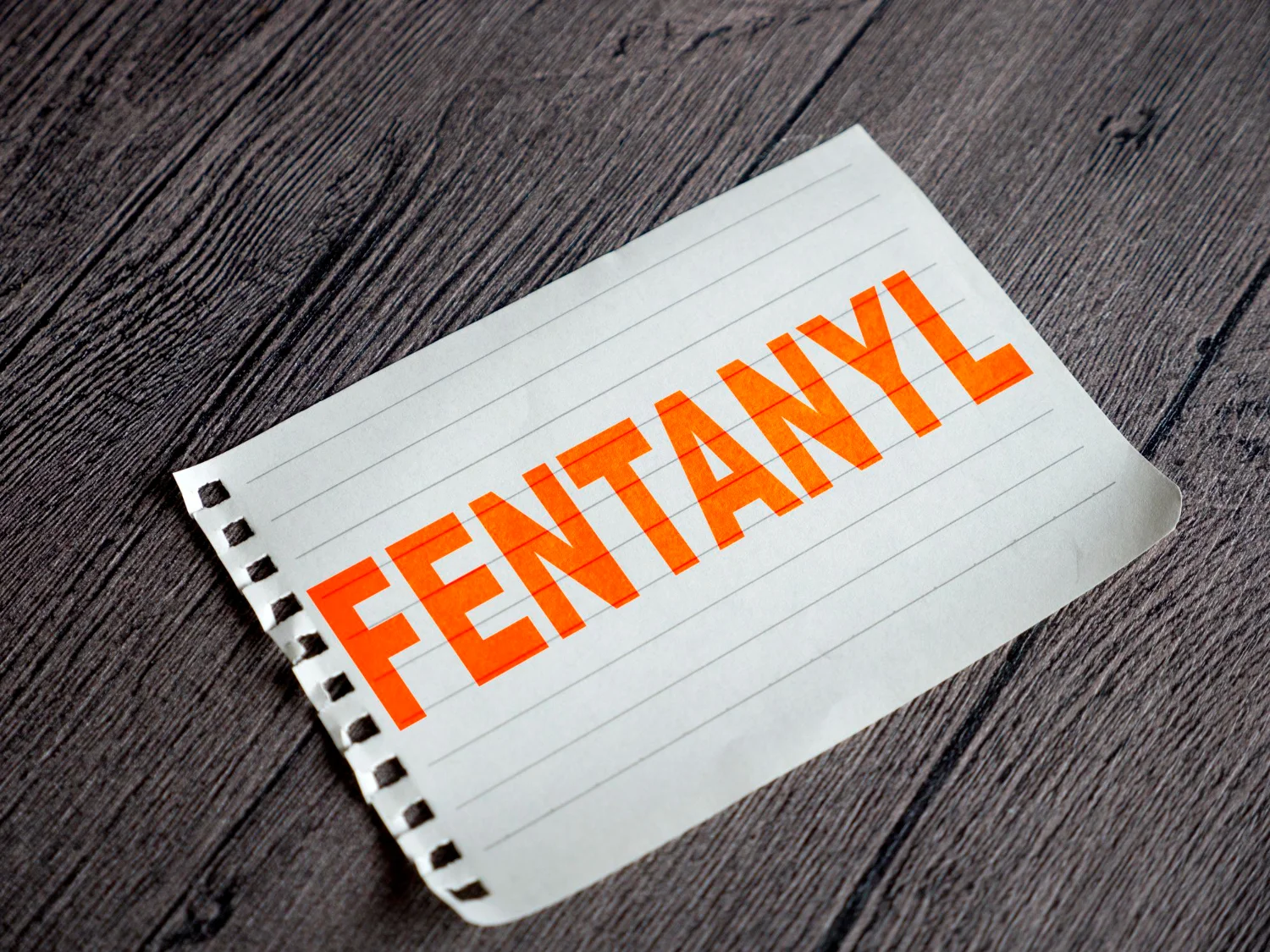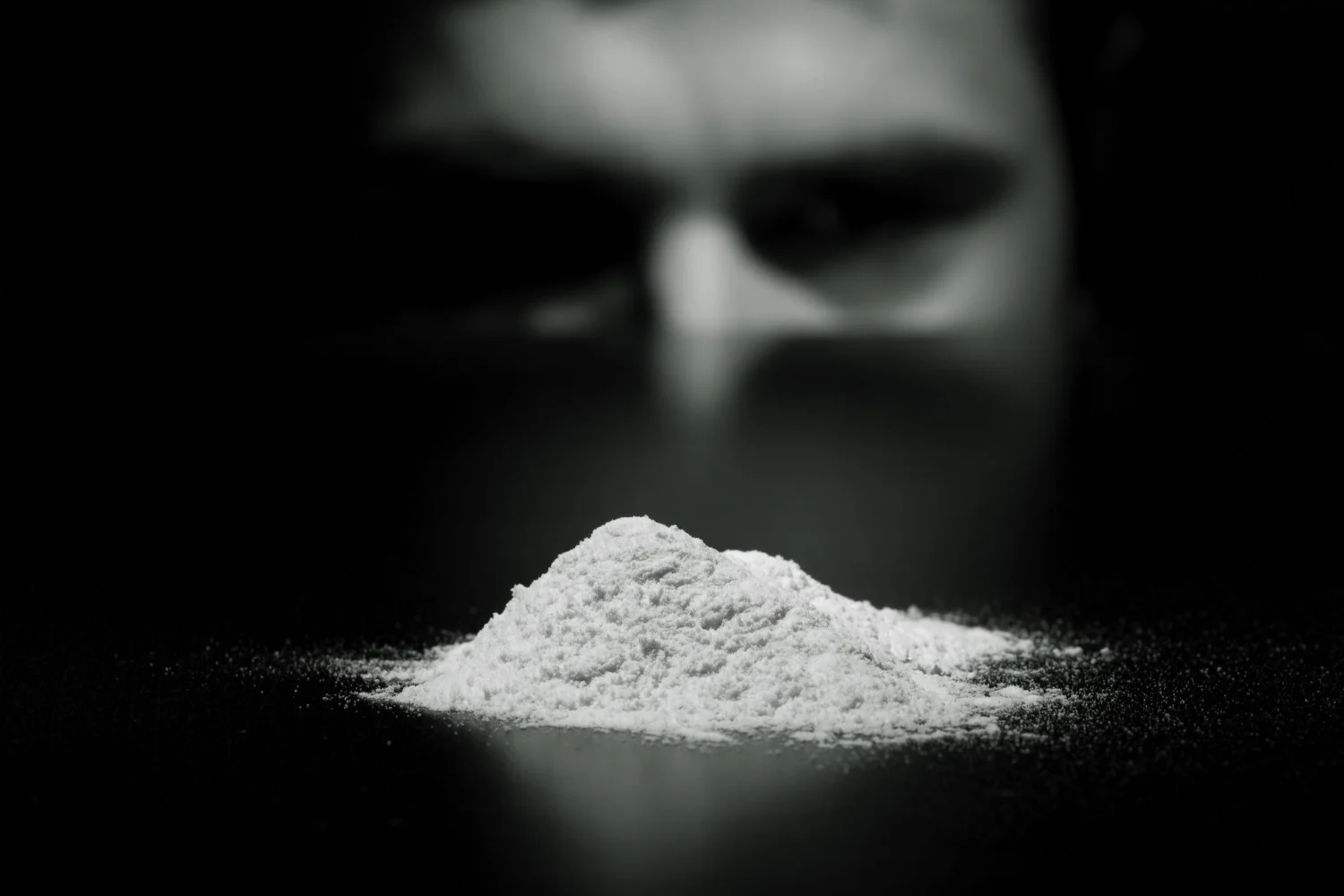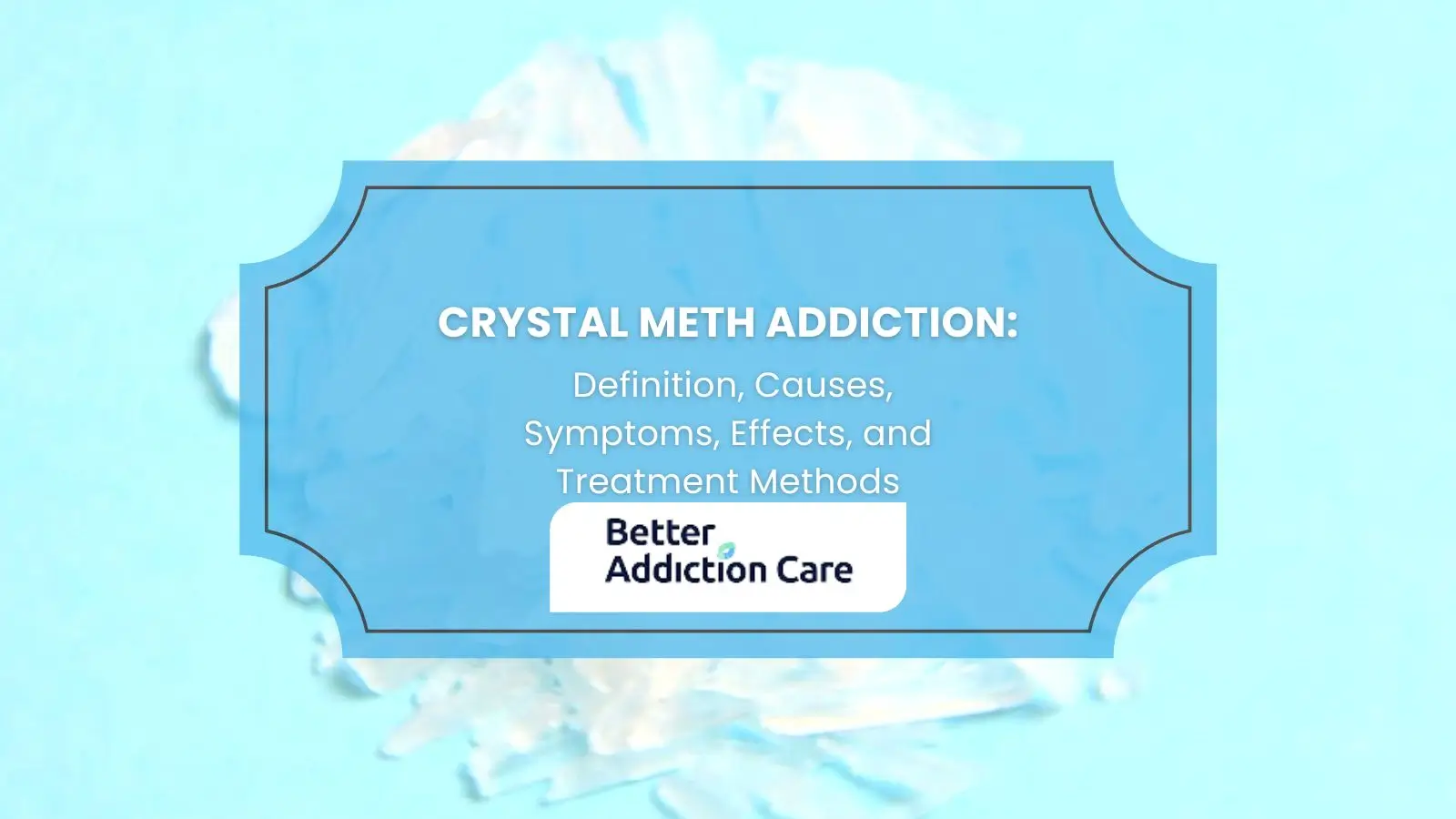Marijuana Addiction: Symptoms, Causes, Effects, and Treatment
Marijuana addiction, cannabis dependency, or cannabis use disorder (CUD) is a severe disorder that involves the compulsive need to consume marijuana, despite fighting with its harmful effects. Marijuana is a drug derived from a plant that gives a relaxing and happy ‘high.’
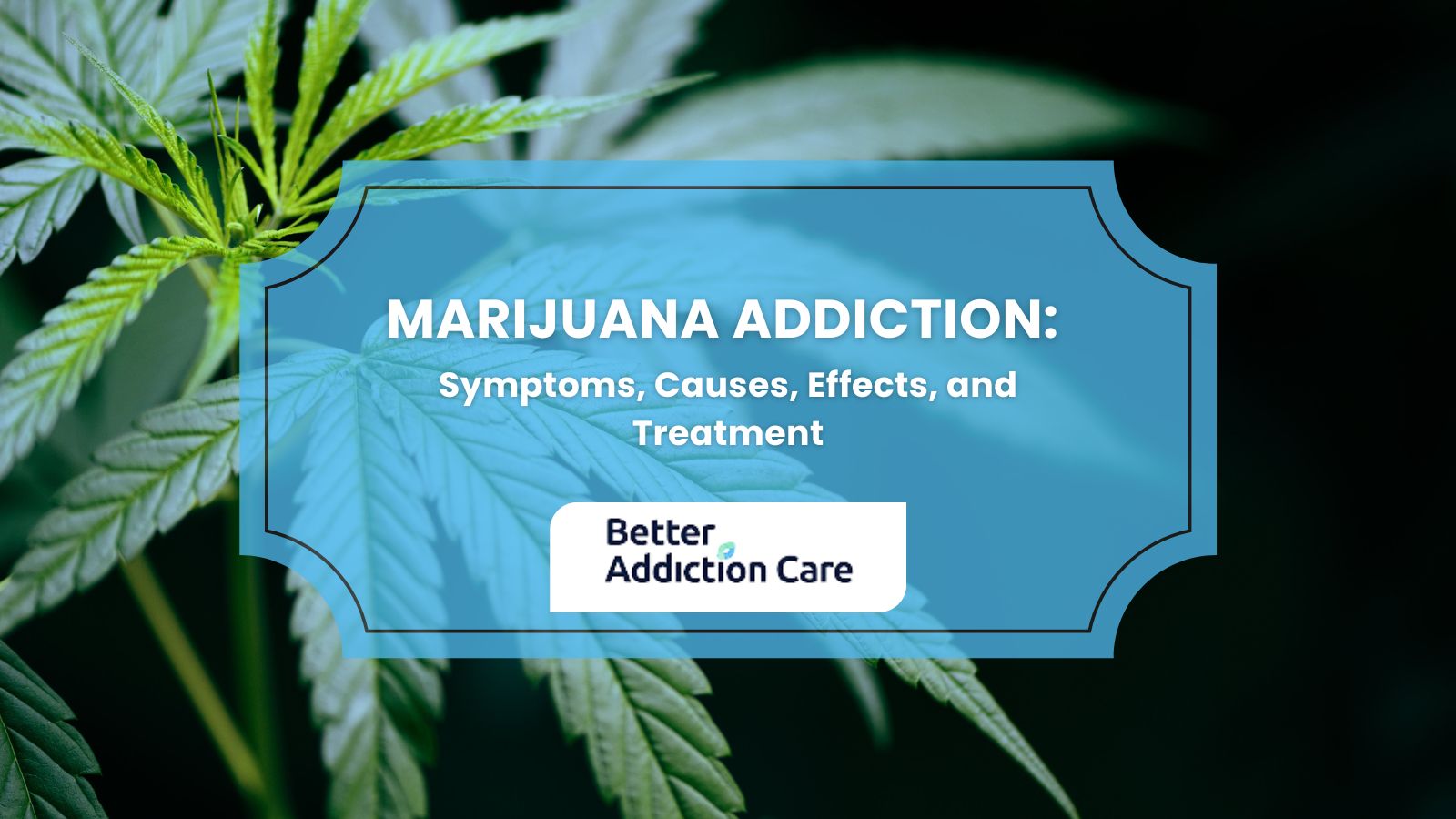
Marijuana addiction, cannabis dependency, or cannabis use disorder (CUD) is a severe disorder that involves the compulsive need to consume marijuana, despite fighting with its harmful effects. Marijuana is a drug derived from a plant that gives a relaxing and happy ‘high.’
The main symptoms of marijuana or pot addiction include an increase in tolerance against the drug, consumption in large amounts, neglecting social life, failed attempts to cut down, withdrawal, and other physical health issues like respiratory problems and weakened immunity.
The causes of marijuana addiction include a complex interplay of biological, psychological, and environmental factors that influence an individual's susceptibility to dependence. Genetic predispositions, psychological conditions such as anxiety and depression, and social environments that normalize cannabis use all contribute to the risk of developing marijuana addiction. According to Mauro, C. M.'s 2019 study, 'Impact of Medical Marijuana Laws on State-Level Marijuana Use by Age and Gender, 2004-2013.', Medical Marijuana Laws (MML) significantly impacted marijuana use patterns among adults aged 26 and older, while having no measurable effect on younger age groups. Following MML enactment, past-month marijuana use among men aged 26+ increased from 7.0% to 8.7% and among women in the same age group from 3.1% to 4.3%. Daily use among past-year users aged 26+ also rose considerably, with men's use increasing from 16.3% to 19.1% and women's use from 9.2% to 12.7%.
The effects of marijuana addiction encompass a range of negative impacts on mental health, physical health, and social and economic well-being. These effects include increased anxiety and depression, cognitive impairments, respiratory issues, chronic fatigue, strained relationships, and financial difficulties, highlighting the comprehensive toll that marijuana dependence takes on an individual's life.
The treatment options include cognitive behavioral therapy (CBT), motivational enhancement therapy (MET), medications, inpatient and outpatient rehabilitation programs, and support groups.
What is Marijuana Addiction?
Marijuana addiction, also known as cannabis use disorder, is a pattern of problematic cannabis use characterized by dependency, cravings, withdrawal symptoms, and continued use despite negative consequences to one's health, relationships, or responsibilities. It involves both psychological and physical dependence where individuals develop tolerance, requiring increased amounts to achieve the desired effect, and experience difficulty controlling or stopping their usage.
According to the CDC, cannabis remains the most commonly used federally illegal drug in the United States with 52.5 million people (19% of Americans) using it at least once in 2021. Approximately 3 in 10 cannabis users develop cannabis use disorder, with increased risk for individuals who begin use before age 18. The CDC monitors cannabis use through multiple national surveys including the Behavioral Risk Factor Surveillance System, Youth Risk Behavior Surveillance System, and National Survey on Drug Use and Health.
What is Marijuana?
Marijuana, weed, or ganja is a psychoactive drug obtained from the leaves of the Indian hemp plant, known as cannabis sativa or cannabis indica. A major portion of this substance is derived from the flowers of this plant, while it is also present in seeds, leaves, and stems in less quantity.
Marijuana is a greenish-gray mixture of dried flowers. Its main ingredient is tetrahydrocannabinol (THC), which is responsible for all the psychoactive actions. THC affects the neurotransmitters of the brain, changes the perceptions of the sense and mood when ingested, and creates a feeling of ‘high’. Marijuana’s usage either has a calming effect or even worsens anxiety, depending on its strain and dosage.
Marijuana addiction, or cannabis use disorder involves an uncontrollable need to consume marijuana, even after making several attempts to quit. Chronic or regular use of cannabis causes substance use disorder, as per a research report by the National Institute on Drug Abuse.
The U.S. Center for Disease Control and Prevention (CDC) reports that some people will develop a Cannabis Use Disorder where they will be unable to stop its usage, particularly those who started in their youth (before the age of 18).
Marijuana use doesn’t cause dependency when taken in light doses or less frequently for occasional recreation. Addiction occurs when a person starts taking the drug regularly and can’t control the consumption.
How is Marijuana Consumed?
Marijuana is consumed in several ways, such as smoking, dabbing, oral ingestion, sprays, topical methods, etc. Smoking is the most common form of using the substance. People consume it with hand-rolled cigarettes known as joints, pipes, or water pipes (bongs). It is vaped through vaporizers, mixed with food items such as gums or brownies, or drunk as tea. Some modern consumption methods include concentrated forms such as oils, waxes, and tinctures, which are ingested orally or vaped using electronic devices.
How Long Does Weed Stay in Your System?
Weed stays in your system between 1 - 90 days, depending on the frequency of use, metabolism, and the type of drug test. Marijuana stays in your blood for up to 12 hours, up to 24 hours in your saliva, up to 30 days in your urine, and up to 90 days in your hair.
Different tests are used to detect the cannabis in your body; saliva is used for quick results, urine is preferred for an accurate guess as it contains the highest concentration, and hair is used as a long detection window.
How Common is Marijuana Addiction?
Marijuana addiction is common because it affects 16.9% of Americans. Approximately 55 million individuals in the US are consuming pot, as per the National Center for Drug Abuse Statistics. Around 78 million natives have used weed at least once in their lives. The report “Understanding Your Risk for Cannabis Use Disorder” by CDC mentions that approximately 3 in 10 people who take marijuana develop a cannabis use disorder. The situation is even worse when it comes to teenagers, as 40% of high school graders have tried marijuana at least once in their life. The same research highlights that people who start taking cannabis in their teenage or adolescence are more likely to catch substance use disorder.
What are the Signs & Symptoms of Marijuana Addiction?
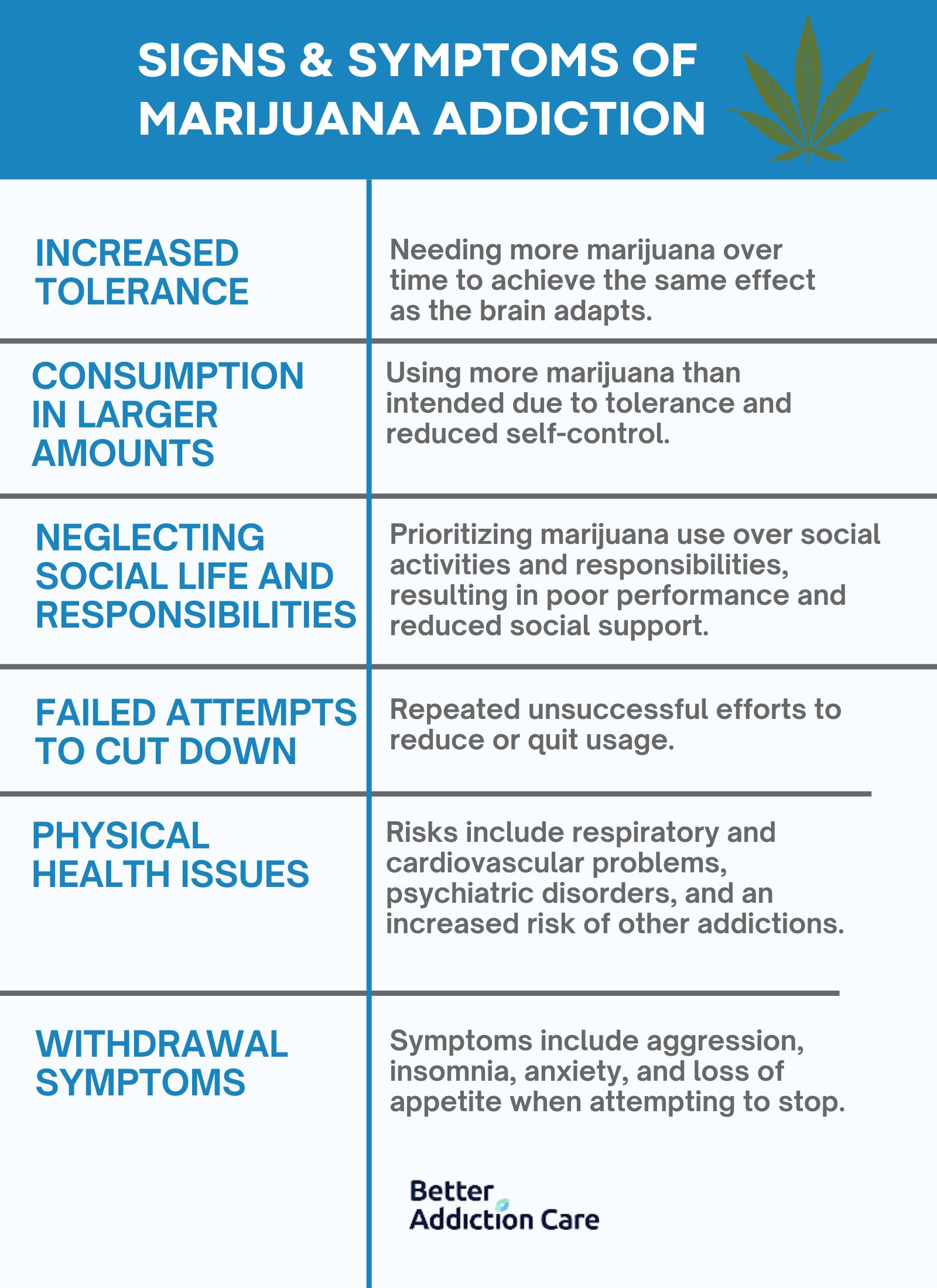
The signs and symptoms of marijuana addiction are increased tolerance, consumption in larger amounts, neglecting social life and responsibilities, failed attempts to cut down, physical health issues, and withdrawal symptoms.
The following is a detail about the signs and symptoms of marijuana addiction.
Increased Tolerance
Increased tolerance happens when a person requires more marijuana to get the same effect as before. This is because the brain’s cannabinoid receptors, sense organs that control pain, mood, and appetite, adjust their threshold or sensation to the high amount of the substance, requiring more drugs to show the responses. Research published on PubMed Central titled: “Cannabis and tolerance: acute drug impairment as a function of cannabis use history” mentions that long-term use of cannabis decreases the subjective and physiological responses to cannabis, leading to increased tolerance.
Consumption in Larger Amounts
Consumption in larger amounts means that people start consuming more cannabis than they planned. The intake sometimes exceeds the measurable quantities, as the addicts are not in their senses to keep a check. Higher consumption usually occurs because of tolerance and decreased self-control.
Neglecting Social Life and Responsibilities
Marijuana addicts start neglecting their social lives and responsibilities. Users prefer getting high with cannabis instead of fulfilling important duties, which leads to poor performance. A 2011 published study, titled “The Association Between Cannabis Use and Perceived Social Support: the Mediating Role of Decreased Social Network,” highlights that the use of cannabis is particularly linked with decreased social size and less perceived social support.
Failed Attempts to Cut Down
People suffering from marijuana addiction have failed attempts to cut down their intake. They experience or observe the negative effects of substance use, due to which they want to quit, but they relapse again.
Physical Health Issues
Marijuana addiction, especially a marijuana overdose creates physical health issues, including adverse effects on the respiratory system and the cardiovascular system. The dangers of cannabis include an increased risk of testicular cancer, psychiatric disorders like schizophrenia, depression, and anxiety, and an increased risk of other addictions.
Withdrawal Symptoms
Withdrawal symptoms refer to signs a person faces when they stop taking an addictive substance. The Harvard Health Publishing’s blog “If cannabis becomes a problem: How to Manage Withdrawal” highlights that when you regularly take cannabis for a long period, relevant body receptors adjust themselves to the high dose of this external stimulation. The body tries to rely on its less-sufficient natural resources when this external source is cut suddenly. This inability to meet the demands of the body leads to aggression, insomnia, loss of appetite, anxiety, and temper flares.
What are the Causes of Marijuana Addiction?
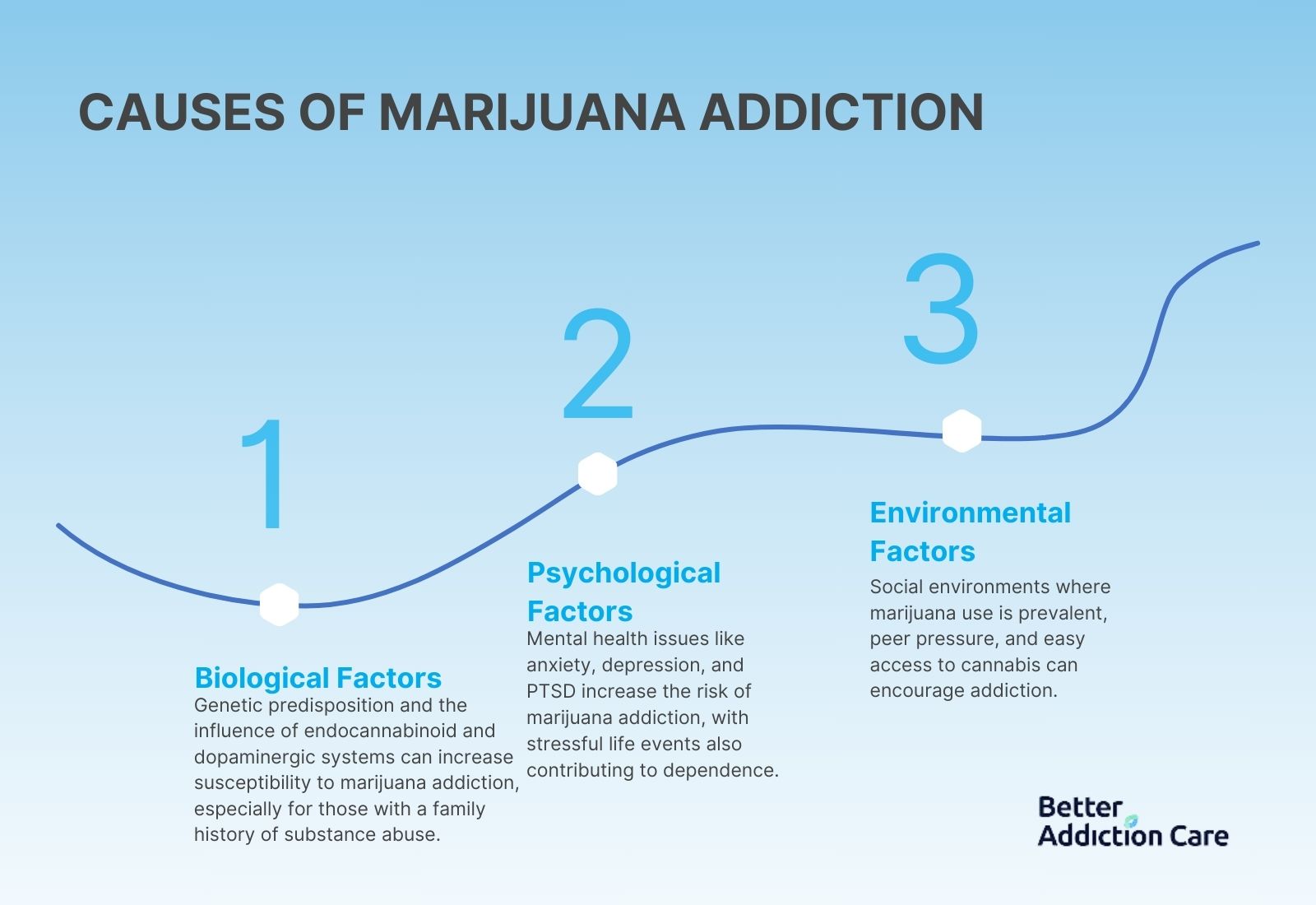
The causes of marijuana addiction are a combination of biological, psychological, and environmental factors.
These causes of marijuana addiction are explained below.
Biological Factors
Biological factors are the genetic and biochemical components that affect human health and behavior. In the case of marijuana addiction, endocannabinoid and dopaminergic systems play a role in substance addiction as chemicals bind to these receptors and change the way they work, as per a published research “A Multi-Level Analysis of Biological, Social, and Psychological Determinants of Substance Use Disorder and Co-Occurring Mental Health Outcomes."
A 2019 study at The New York Academy of Sciences titled: The Neurobiology of Addiction mentions that genetic markers are linked with addiction, referring to the fact that people with a family history of dagga addiction have more chances of getting addicted.
Psychological Factors
Psychological factors, such as anxiety, depression, or PTSD make a person more sensitive to marijuana addiction. The study “Psychosocial Determinants of Cannabis Dependence: A Systematic Review of the Literature,” states that stress and critical life events such as parental death or separation lead to marijuana dependence.
Environmental Factors
Environmental factors are the external elements that make a person misuse substances such as marijuana, leading to an addiction. Social environments where cannabis use is common, pressure from peers, and easy access to marijuana pose a serious threat, leading to increased cases of addiction.
What are the Effects of Marijuana Addiction?
Marijuana addiction has many negative mental health, physical health, and social and economic effects.
These negative effects of marijuana addiction are listed below.
Mental Health Effects
Mental health effects refer to the negative impact of marijuana on the brain. A list of these effects is listed below.
-
Anxiety: Chronic marijuana use increases the chances of anxiety, leading to panic disorders. While some users initially consume cannabis to reduce anxiety, a report from 2021 at Pubmed Central says that its long-term use often increases the risk of anxiety disorders.
-
Depression: Marijuana dependence leads to depression risks and worsens depressive symptoms. “Depression and Marijuana Use Disorder Symptoms among Current Marijuana Users” by Lisa Dierker et. al. mentions that depression is positively associated with marijuana use disorder, with its symptoms being more common in adults.
-
Cognitive Impairment: The mental health effects of overuse of marijuana include memory loss, learning disability, and impairment in understanding information. The research titled “Heavy cannabis use, dependence and the brain: A Clinical Perspective” has found suggestive evidence of cognitive failure due to cannabis use disorder that may recover after a period of discontinuity.
-
Difficulty in Focusing: Difficulty in focus refers to the inability of a person to maintain attention on a specific task. A blog on Health Harvard Publishing mentions that long-term use of cannabis causes brain fog and attention struggles.
Physical Health Effects
The physical health effects caused by marijuana addiction are explained below.
-
Respiratory Issues: Respiratory issues are the problems linked with the lungs and airways. Lung.org mentions that long-term marijuana causes difficulties such as bronchitis, cough, and lung irritation.
-
Constant Fatigue: Heavy use of marijuana is likely to cause chronic tiredness and sleep during the day. A cross-sectional study at PubMed Central among 180 individuals with cannabis dependence verifies the fact that almost 61% of males and 42% of females experience tiredness. The users often have disturbed sleep and wakefulness that hinder their normal working.
-
Less Motivation: Prolonged marijuana use causes ‘amotivational syndrome’ where a person lacks the desire to carry out their daily tasks. Evidence in the study “Non-Acute Effects of Cannabis Use on Motivation and Reward Sensitivity in Humans: A Systematic Review” supports that marijuana addiction leads to cannabis-specific effects on motivation, leading to a low desire to complete a task.
-
Weakened Immunity: Weekend immunity means the body's inability to fight off infections and diseases. Marijuana abusers may suffer from low immunity due to a weak immune system. THC is known to have an impact on the body’s systems and may lead to poor pathogen resistance.
Social and Economic Effects
The social and economic effects of marijuana addiction are listed below.
-
Impact on Relationships: Marijuana addiction impacts a person’s relationship with others, causing tension in a family, friendship circle, and business network. The overuse of this substance hurts relational connections and also reduces work efficiency, according to the study “Cannabis Unveiled: An Exploration of Marijuana’s History, Active Compounds, Effects, Benefits, and Risks on Human Health” by NIH.
-
Less Focus on Work: Marijuana addiction makes a person less attentive at work and may impact their ability to think and plan. An evidence-based study in 2011 at PubMed Central explains that getting high may impair a user’s cognitive functions.
-
Financial Problems: Financial problems occur due to the actual cost of buying marijuana, which could be way higher in many cases. This addiction further leads to delayed bill payments as the person is too lazy to think about it.
How is Marijuana Addiction Diagnosed?
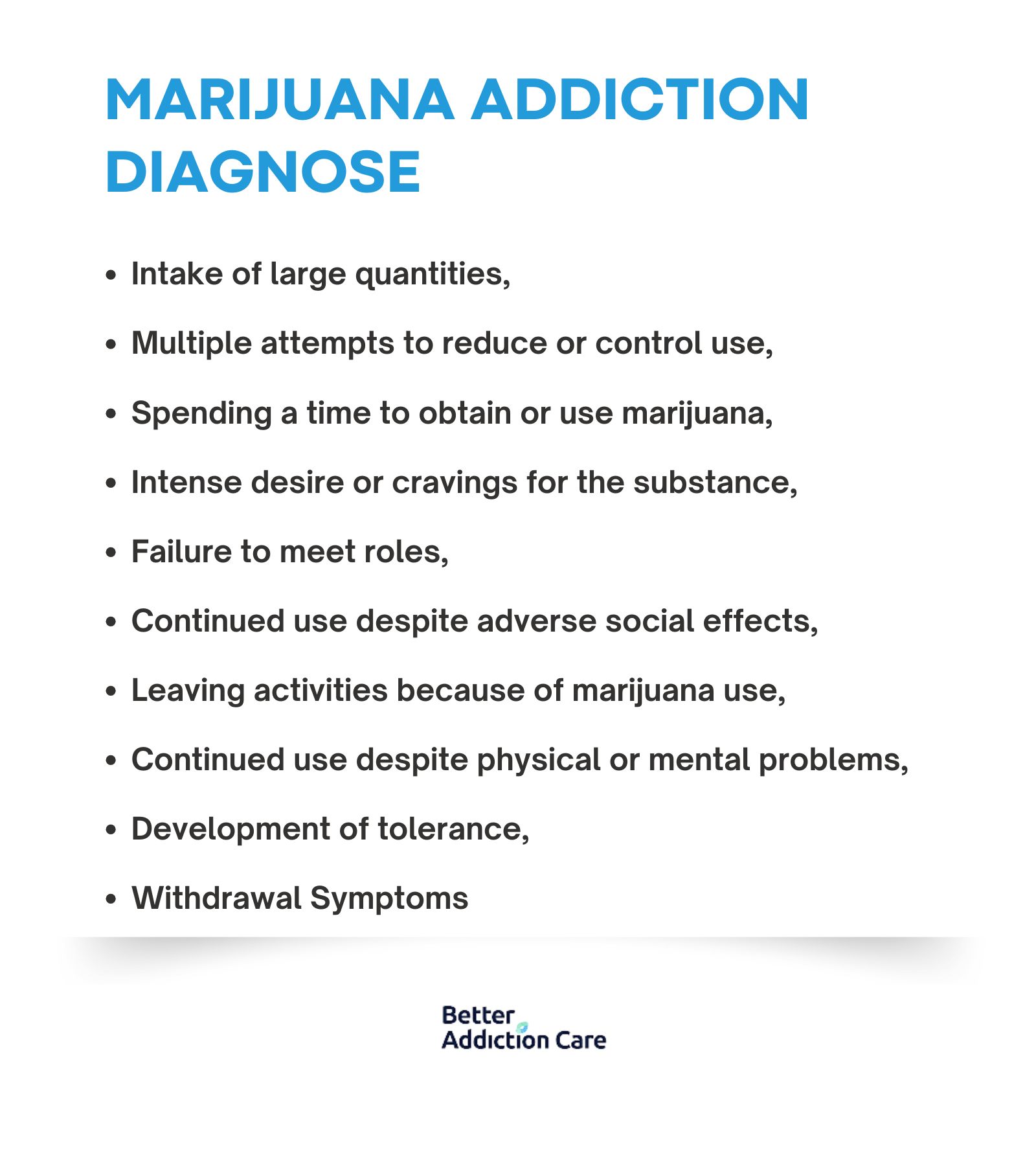
Marijuana addiction is identified through a series of tests by qualified healthcare using the DSM-V criteria. The initial check is done with laboratory tests and family history. Medical professionals conduct a detailed diagnosis on the basis of the American Psychiatric Association’s Diagnostic and Statistical Manual of Mental Disorders (DSM-5). The DSM-5 criteria states that cannabis use disorder occurs when a person exhibits at least two of the following symptoms within 12 months:
-
Intake of large quantities,
-
Multiple attempts to reduce or control use,
-
Spending a considerable amount of time to obtain or use marijuana,
-
Intense desire or cravings for the substance,
-
Failure to meet roles,
-
Continued use despite adverse social effects,
-
Leaving activities because of marijuana use,
-
Continued use despite physical or mental problems,
-
Development of tolerance,
-
Withdrawal Symptoms,
Based on the number of symptoms exhibited, CUD is classified into one of the following categories:
-
Mild CUD (two to three symptoms),
-
Moderate CUD (four to five symptoms),
-
Severe CUD (six or more symptoms),
What are the Treatment Options for Marijuana Addiction?
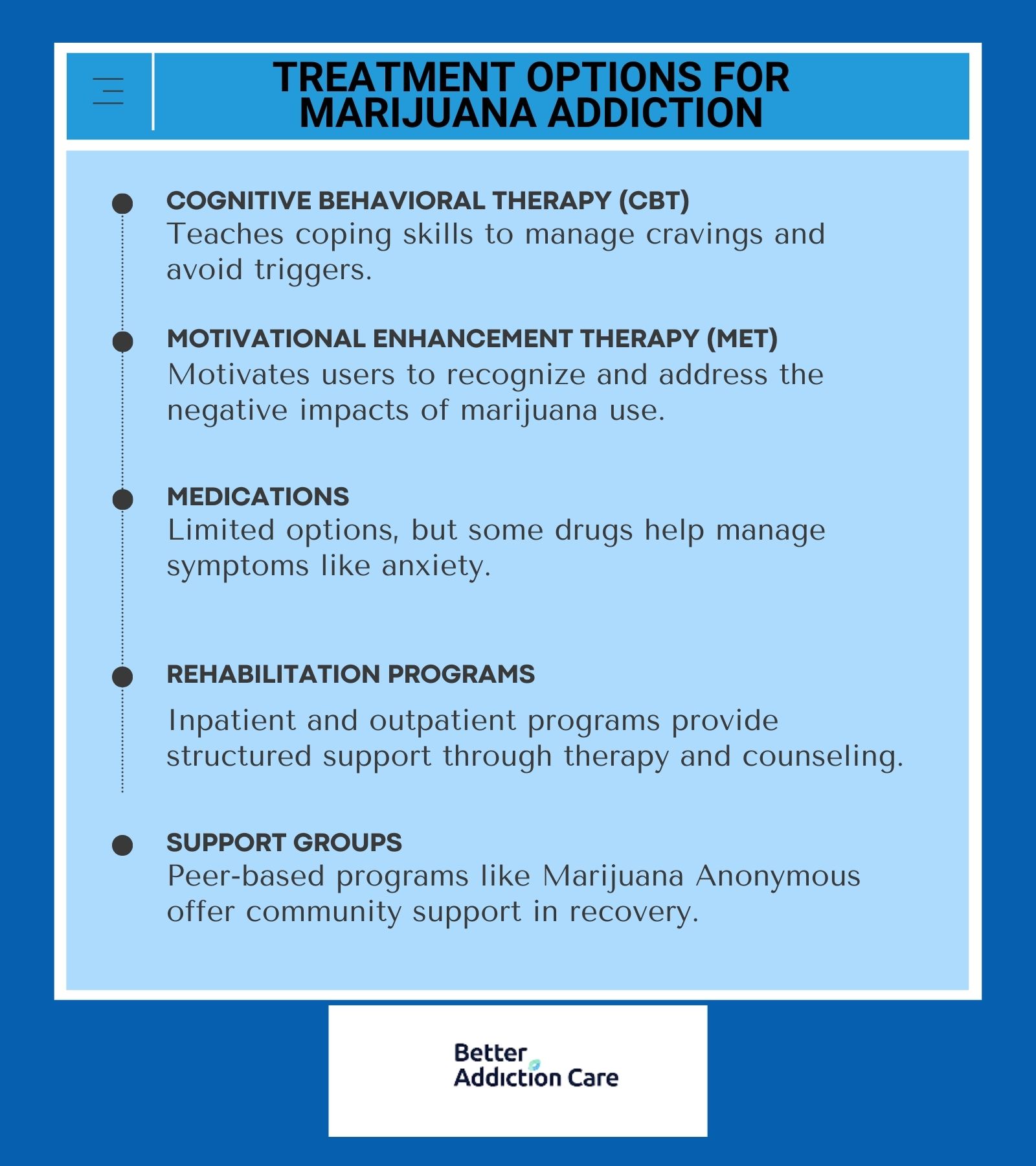
The treatment options for marijuana addiction include cognitive behavioral therapy (CBT), motivational enhancement therapy, medications, inpatient and outpatient rehabilitation programs, and support groups.
These treatment options are explained below.
Cognitive Behavioral Therapy (CBT)
Cognitive behavioral therapy, or CBT, is a form of therapy that assists a person in changing negative ways of thinking and behavior into positive ones. CBT is highly effective for coping with substance use disorders (SUDs). It aims at coping skills for avoiding stimuli and cravings. The CBT program is conducted in 12 - 16 sessions, with signs of recovery starting to appear after 1 - 2 days of quitting and peaking around 2 - 6 days. CBT is great for the quick recovery of mental health disorders, including substance use disorders.
Motivational Enhancement Therapy (MET)
Motivational enhancement therapy (MET) is a brief counseling therapy used for substance use disorders like marijuana addiction. The goal of MET is to encourage participants to realize the destructive results of the substance and motivate them to quit weed consumption. MET is usually performed for 4 sessions. It takes 6 sessions, too, for patients with severe CUD. A Study published by Cochrane titled: Psychosocial interventions for cannabis use disorder” support that a combination of MET and CBT is more effective in the treatment of marijuana use disorder.
Medications
The U.S. Food and Drug Administration (FDA) hasn’t approved any pharmacological treatment or drugs, particularly to manage cannabis addiction. No drug has been found effective enough to treat addiction on a broader scale, and cannabis-dependent patients find it difficult to stop using the substance. The NIH research report titled: “Pharmacological Treatment of Cannabis Dependence” mentions that Buspirone (an anti-anxiety drug) has only been beneficial in handling the marijuana overuse symptoms in clinical trials. However, physicians may prescribe medicines for underlying conditions or to control the symptoms, such as depression and anxiety.
Inpatient and Outpatient Rehabilitation Programs
Inpatient programs require a person to be admitted to a facility for some time, while outpatient programs let the person live with their family and just attend sessions. They offer scheduled treatments such as therapy, support groups, and medical treatment.
Inpatient rehabilitation programs may last for 30 to 90 days under 24/7 intensive care. An outpatient plan also lasts for 60 to 90 days, with duration depending on the severity of the addiction.
Support Groups
Support groups are programs where members meet to discuss and seek help from individuals going through similar experiences. There are many organizations that work for the betterment of marijuana addiction-affected patients. For example, Marijuana Anonymous (MA) is a 12-step community that offers free support to users globally. A few other notable associations are SMART Recovery and In The Rooms (ITR).
What are the Withdrawal Symptoms of Marijuana Addiction?
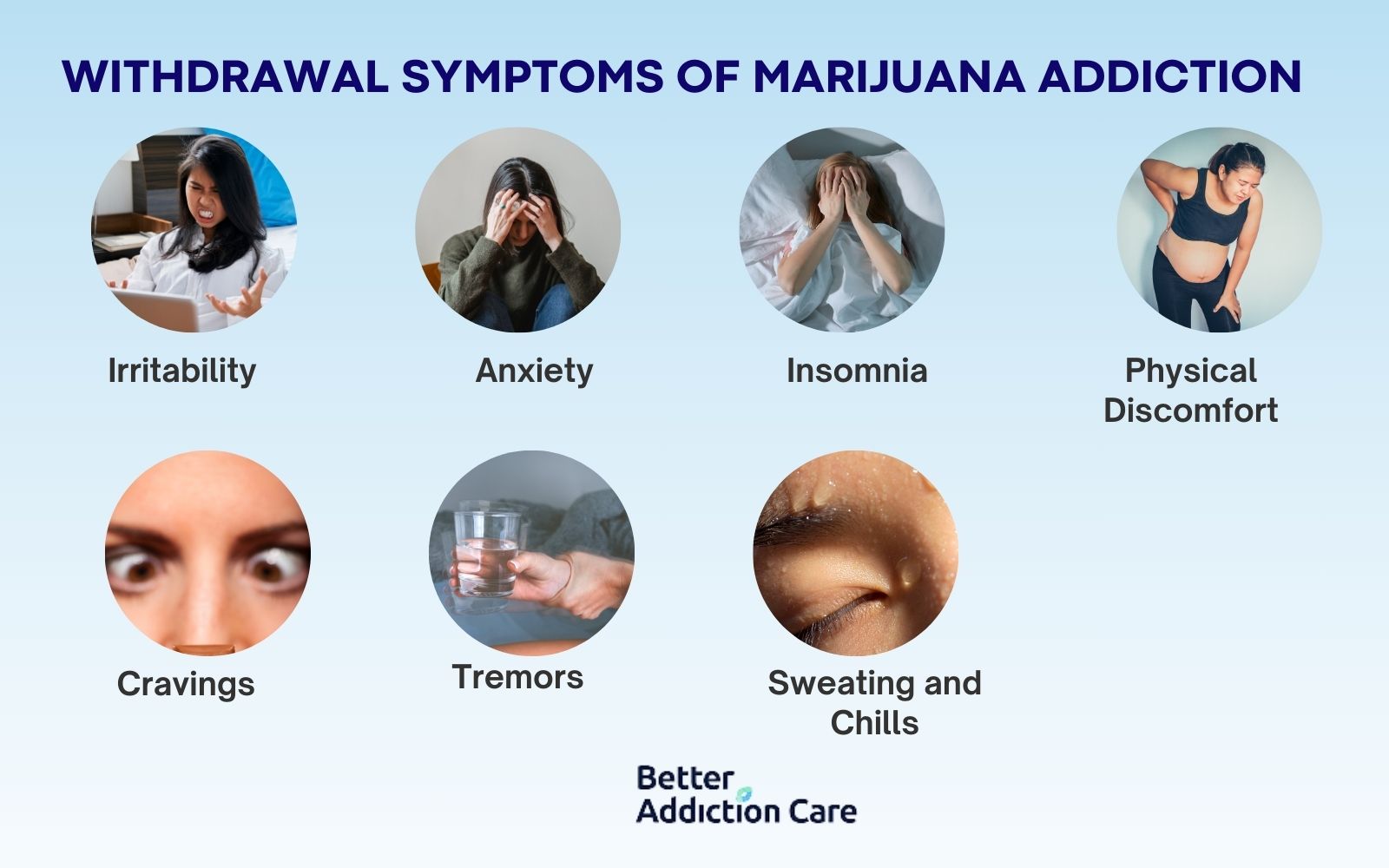
Marijuana withdrawal, or cannabis withdrawal, is a physical and psychological discomfort that occurs when a person suddenly stops consuming the substance after heavy and regular use. As per a study titled “Prevalence of Cannabis Withdrawal Symptoms Among People With Regular or Dependent Use of Cannabinoids: A Systematic Review and Meta-analysis” at JAMA Network, 47% of cannabis addicts face withdrawal symptoms after the discontinuation of the drug.
The common marijuana withdrawal symptoms are given below:
-
Irritability: Irritability is defined as an increase in restlessness and irritation. It is one of the most common symptoms of marijuana withdrawal and leads to mood swings. Try relaxation activities such as practicing deep breathing or meditation to cope with irritability.
-
Anxiety: Anxiety is described as a feeling of nervousness and unease. Anxiety leads to chronic stress and even causes panic attacks. Exercising or participating in any physical activity like yoga releases the anxiety of the addict.
-
Insomnia: Insomnia refers to difficulty falling asleep or the tendency to wake up during the night. Insomnia is harmful to one’s health and often worsens the signs of withdrawal. Herbal teas or melatonin supplements help to deal with insomnia.
-
Physical Discomfort: Physical discomfort refers to general body aches and pains. It’s important to drink a lot of water, engage in mild stretching, or take over-the-counter medicines (OTC) such as acetaminophen, ibuprofen, or aspirin to handle physical discomfort.
-
Cravings: Cravings are the strong desire to consume marijuana after the discontinuation. Marijuana cravings sometimes become intense and hard to challenge. It’s essential to divert your mind, avoid loneliness, engage in some activities, or seek the company of friends to cope with cravings.
-
Tremors: Tremors are involuntary or uncontrolled shaking of the limbs, including hands, arms, and legs. They are usually painful and cause discomfort. Light exercise and deep breathing help reduce the severity of tremors.
-
Sweating and Chills: Individuals usually face excessive sweating, followed by periods of cold, after they stop taking marijuana. Sweating and chills are uncomfortable and disrupt a person’s daily life. The affected person should try to wear modest dressings, maintain room temperature, and drink a lot of water to manage sweating and chilling.
How is Marijuana Addiction Differentiated from Other Addictions?
Marijuana addiction shares many similarities with other substance use disorders, but the differences are still considerable.
Here is how marijuana addiction is different from other addictions:
What is the Difference Between Marijuana and Hashish Addiction?
Marijuana addiction is the dependence of a person on cannabis. Similarly, hashish addiction occurs due to over-consumption of the same substance. Both marijuana and hashish are obtained from the cannabis plant, where marijuana is made from the dried leaves and flowers, while hashish is produced from the flower’s resin of the same plant.
The key difference between both addictions is the content of THC. Hashish or hash usually has a higher concentration of THC, making it more potent. Hence, hashish addiction shows more intense psychological dependence and strong withdrawal symptoms.
What is the Difference Between Marijuana and Heroin Addiction?
Marijuana is a psychoactive drug obtained from the cannabis plant, used for relaxing and euphoric effects. On the other hand, heroin is derived from the opioid morphine and has powerful pain-relieving properties.
Marijuana causes psychological dependence in terms of addiction, while heroin leads to powerful physical and psychological dependence. Marijuana addiction is less harmful, but heroin carvings pose a higher risk of overdose or even death.
Both addictions differ in terms of their treatments, as marijuana addiction is treated with motivation and cognition-based therapies, whereas heroin addiction requires drugs to manage the disease.
What is the Difference Between Marijuana and Cocaine Addiction?
Marijuana addiction arises from the long-term use of cannabis, while cocaine addiction occurs from high doses of cocaine, a white powder. Overuse of both substances causes dependence, but the severity and the nature of addiction differ.
Marijuana addiction only causes mental dependence, but cocaine addiction leads to physical cravings and is associated with depression, and serious health risks, like heart attack.
How Does CBD Addiction Withdrawal Differ From Marijuana Addiction Withdrawal?
CBD addiction withdrawal differs from marijuana addiction withdrawal primarily because CBD doesn't cause addiction or withdrawal symptoms. Unlike marijuana's THC component, which creates dependence and significant withdrawal effects, CBD is non-intoxicating and doesn't produce withdrawal symptoms when stopped. Marijuana withdrawal typically involves irritability, anxiety, sleep problems, decreased appetite, restlessness, depression, and physical discomforts including abdominal pain, tremors, sweating, fever, chills, and headaches. These marijuana withdrawal symptoms commonly begin within 24 hours after stopping use, reach their highest intensity during the first week, and may continue for up to a month. The fundamental difference is that marijuana withdrawal presents numerous psychological and physical symptoms, while CBD doesn't cause withdrawal effects because it lacks addictive properties.
Is K2/spice Addiction More Severe Than Marijuana Addiction?
Yes, K2/Spice addiction is more severe than marijuana addiction. Synthetic cannabinoids like K2 or Spice are chemically engineered to mimic THC, the psychoactive component in marijuana, but they often have unpredictable and more potent effects. According to a study by University of Bath, 2021, ''Spice' withdrawal symptoms more severe than cannabis – new study.', 67% of participants who attempted to quit Spice reported experiencing at least three withdrawal symptoms, significantly worse than those quitting cannabis. Withdrawal symptoms from Spice included sleep issues, irritability, low mood, heart palpitations, and cravings, all rated more severe than cannabis withdrawal. Effects of Spice were consistently rated more harmful than cannabis, with quicker onset but shorter duration. Tolerance to Spice develops more rapidly than cannabis, requiring users to take larger doses more frequently to achieve the same effects. Researchers concluded that Spice is a far more harmful drug than cannabis, with users experiencing a range of severe withdrawal symptoms when attempting to quit.
Synthetic cannabinoids have been associated with serious health risks such as acute kidney injury, cardiovascular issues, seizures, and even death, risks not typically observed with natural cannabis use. The higher potency and unpredictable composition of synthetic cannabinoids contribute to a greater addiction potential and more severe health consequences compared to marijuana.
Do Marijuana Addiction Sufferers Commonly Develop Kratom Addiction?
No, marijuana addiction sufferers do not commonly develop kratom addiction. According to Falise, A. M.'s 2023 study, 'Polysubstance use profiles among US adults using Kratom (Mitragyna speciosa): A latent class analysis using The National Survey on Drug Use and Health (NSDUH).', Among kratom users, 67.8% reported past 12-month marijuana use, with 63.3% falling into the "marijuana/alcohol/tobacco (MAT)" profile. Kratom users typically consumed an average of 3.4 additional substances within the past 12 months, showing polysubstance use is common but not establishing a specific progression from marijuana to kratom.
Related Articles
Treatment Centers in Virginia





